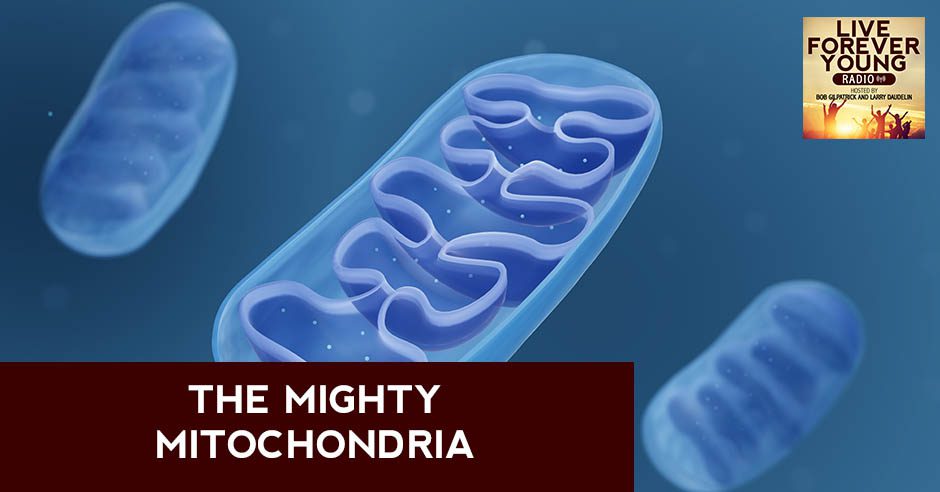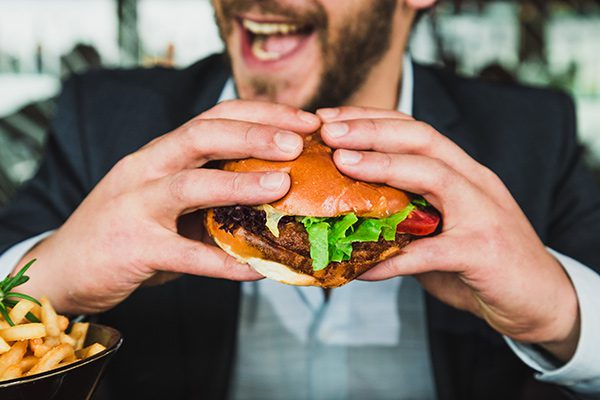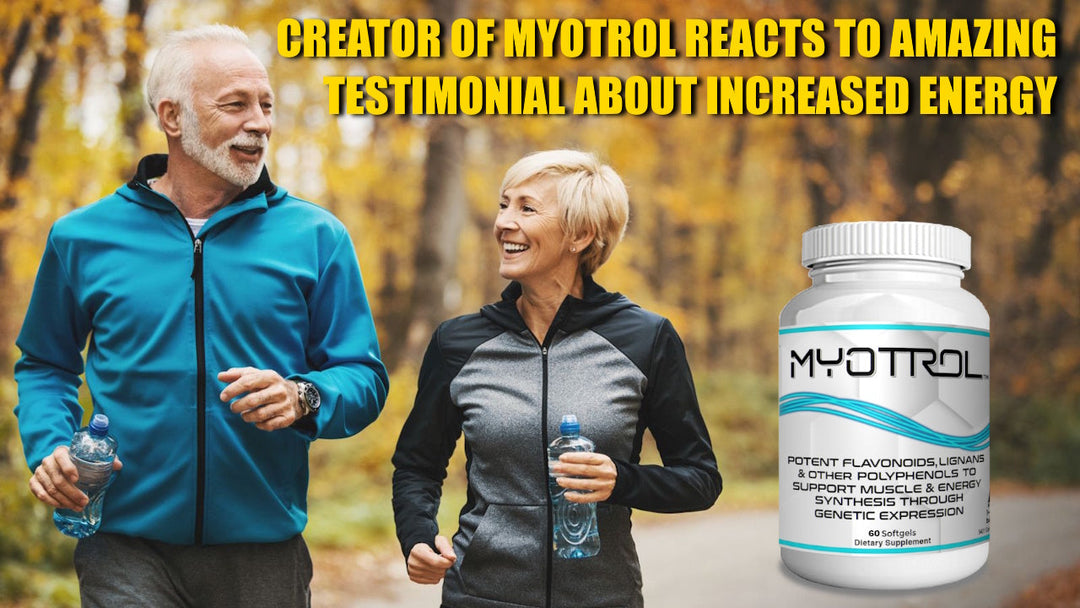The Mighty Mitochondria
 Did you know that you have two different sets of DNA? One for your body and one for your mitochondria. On today’s show, Bob Gilpatrick and Rollie Culp talk about the mighty mitochondria, the powerhouse of your cells, and the importance of keeping them in tip top shape for your health.
Did you know that you have two different sets of DNA? One for your body and one for your mitochondria. On today’s show, Bob Gilpatrick and Rollie Culp talk about the mighty mitochondria, the powerhouse of your cells, and the importance of keeping them in tip top shape for your health.
Learn all about the role they play in the aging process. Find out what problems and diseases you can run into if your mitochondria become dysfunctional and what actions you can take to keep your mitochondria healthy so you can age gracefully.
---
Listen to the podcast here
The Mighty Mitochondria
The Powerhouse of Your Cells
Did you know that you have two different sets of DNA? One is for your body and one is for your mitochondria. In this episode, we talk about the mighty mitochondria, the powerhouse of your cells and the importance of keeping them in tip-top shape for your health.
Learn what mitochondria are, the role they play in the aging process and what problems and diseases you can run into if your mitochondria become dysfunctional. Find out what simple actions you can take to keep your mitochondria firing on all cylinders and feeling great so you can age gracefully. Sit back, relax and get ready to live forever young.
---
Welcome to the show. I am here with Rollie to talk about mitochondria. How are you doing, Rollie?
I’m good. We’re excited because we’re talking about the thing that gets down to the nitty-gritty of a human body, which is the mighty mitochondria. We're going to talk about the main things that you could do to avoid having dysfunctional mitochondria, the problems it can cause, the things that you don't want any part of and then what you could do to make sure that doesn't happen. If you are also experiencing it, we’re going to talk about how to get it under control. We hope you like this episode.
Most people have heard of mitochondria. Some may not have so what are mitochondria? They are these little things called organelles that are inside your cells. If you imagine, a cell is like your fist. If you were able to open it up, you'd see all these little dots that are these little energy-producing machines working like crazy to spit out energy so that the rest of the cell has the energy to live on, function on and perform its functions. Are those organelles like the batteries?
There are many different types of organelles but mitochondria are one type of organelle. They do many things but their primary responsibility is to produce energy. They're spitting off these little bits of energy that the rest of the cell is absorbing and using. The mitochondria within the cells have few networks. They're communicating to different cells and cells themselves are communicating with neighboring cells. The mitochondria help with this communication.
It sounds like a dance. This is an important part also. Normally when people think of DNA, they think about the nucleus of a cell where the DNA is but these little mitochondria also have DNA. The DNA is much less robust in terms of the number of genes and proteins it’s encoding for because, over time, the DNA that was originally in the mitochondria donated itself to the nucleic DNA and only left itself with 37 different genes. It only makes about 13 proteins whereas the totality of your body makes about 100,000 different proteins. Those thirteen proteins are important, including four of them, which are directly involved in the production of energy.
There’s nucleic DNA, which is not the same as mitochondrial DNA. The mitochondrial DNA is its own thing and there are about thirteen proteins that it produces. Four of them know that they are directly related to this creation of energy. They know which of the four proteins does which thing and what they all end up doing to produce this energy as the result. That's in-depth but I like it. You have two kinds of DNA. That's what it means. It's important to know because this is extremely valuable DNA. It's making the energy that your body needs.
Without it, you wouldn't be able to live. Ninety-five percent of all your energy is made in your mitochondria. Without that DNA that is producing these proteins that are helping to produce the energy, you wouldn't have human life. We’re going to talk a lot about protecting your mitochondria including the DNA inside your mitochondria because as we age, the mitochondria don't function as well.
Your physical age is directly related to the health of your mitochondria. That's why this is so important. You could have a person that’s 50 years old and another person that’s 50 years old. If one of them hasn't been caring for their mitochondria, is getting old and not functioning as well, that person is going to physically look a lot older than the person who has healthy mitochondria.

If you don't have the mitochondrial functioning properly, not only are you going to not feel good but it's going to cause you to age faster in a way. In a little bit, we're going to talk about the different things you have to do to maintain healthy mitochondria, including the nutritional aspects and some nutrients that you can get in nutritional supplements that help tremendously.
We did an episode called The New Science of Anti-Aging where we go over a lot of that but this is going to be a different look at the mitochondrial side of it. It’s the little microscopic side as opposed to the whole overview like we did in that show. As we go, we'll talk a little bit about a combo of two products called the Dynamic Combo. It contains everything that you need from a nutritional standpoint and an inflammation standpoint that you need to have healthy mitochondria.
It's the Boomer Boost’s Gladiator Barley and Heirloom Barley which are sprouted barley seeds. You can go to BoomerBoost.com and search Dynamic Combo. It will pull it up. Let's tell people about why Dynamic Combo, increasing your oxygen and exercise and keeping your inflammation down are important. With where we were at, we were with the dysfunctional mitochondria. We were talking about how it causes premature aging and if the mitochondria create energy, then having dysfunctional mitochondria would make you lose energy. That's one of the other things. You lose energy and then because you have dysfunctional cells, it can lead to mutations and eventually be a cause of cancer.
There is a whole theory of cancer that it's a mitochondrial disease. It is poor functioning mitochondria that cause a cell to become cancerous. Here's one of the main things. Mitochondria are only as healthy as the level of inflammation in your body, meaning the higher your inflammation, the more damage occurs to your mitochondria and the less functional they are. It's a good thing to know your inflammation. You want to know how much inflammation is in your body so you can do things to get it down if you need to.
There is this blood test called CRP or C-Reactive Protein. You want that number to be below 0.5. For most people, it's around 3, which is 6 times higher than you need it to be and that's why people's mitochondria don't stay healthy for their whole life long. By the time you get to be about 75, if you have a high level of inflammation in your mitochondria, you're going to become dysfunctional and start to suffer from numerous different types of adult-onset diseases.
What are the things that keep inflammation high, particularly at your mitochondria? It’s having iron levels that are too high. We know that because mitochondria are powerhouses, they are throwing off molecules of superoxide, which are highly caustic molecules that are burning your body up. It's also throwing off hydrogen peroxide. When you have high iron, the iron interfaces with the hydrogen peroxide and creates a molecule similar to superoxide but even more caustic.
You want your iron level to be high enough so that it works properly inside of your red blood cells because your hemoglobin molecules require iron to transport oxygen. Oxygen is a very important part of the health of your mitochondria and the ability to produce energy so you want iron to bring oxygen to the cells but if you have too much iron, then it's going to cause extensive inflammation and damage to your mitochondria.
We know a couple of people who have high iron and an easy way to deal with it is by giving blood. You can relieve the amount of iron in the blood that way. There are also some other supplements you might want to look at that can assist with it. Too much iron creates too much inflammation, even worse than superoxide.

Watch your iron level. When you go to give blood, they will tell you your iron level. You want it to be in the middle of the range to lower. If it starts to creep up above the middle of the range, then you know you probably have excessive inflammation. The other thing is that, in general, the production of energy is creating inflammation but also, our bodies produce antioxidants from our genetic code. We have a code to make a neutralizing molecule for superoxide.
It's called superoxide dismutase. While people are young, their mitochondria are pretty healthy because they're making lots of SOD but as you age, you make less SOD. You have more inflammation and your mitochondria begin to age faster. Therefore, you age faster. You want to be able to take in SOD by mouth as you age so it can replace what you've stopped making and that is one of the compounds in our Dynamic Combo.
In the Gladiator and Heirloom Barley, there are large amounts of SOD. When we get older, like almost everything, we stopped making as much as SOD, SuperOxide Dismutase, to combat the superoxide, the free radicals and the inflammation that's causing us to burn up like a log in a fire. We want to slow that down so we include the SOD in the barley.
The other thing that’s important for keeping your inflammation down is diet. Most people eat too much sugar. It's the American way. We talked about America's sugar addiction in an episode we did. It's called American Sugar Addiction. Check it out.
Too much sugar is going to create lots of inflammation. We aren’t going to explain exactly how that happens because that's in that other show. You want to eat less sugar and eat more good fats because when you can burn fat for fuel, it's much more efficient and you produce a lot less superoxide so you have less inflammation. That's that inflammation part of it.
The other part is nutrition. Human bodies need energy. Ultimately, the way mitochondria make energy is from the food that you eat. That's why you want to have very efficient, burning, good fats. You also need micronutrients and macronutrients that will help to make your mitochondria function properly. Some of the micro ones are Coenzyme Q10. Part of the Dynamic Combo is the B vitamins, magnesium, alpha-lipoic acid and acetylcarnitine.
We know that all of these are important micronutrients but we also know the macronutrients. You're going to need good fats. You're also going to need amino acids, which are the building blocks of proteins, which are macronutrients. You also have to have metabolic enzymes, which are the glue that helps to take these amino acids and make them into proteins. If you are going to make thirteen different proteins from the mitochondrial DNA, they're going to be made from amino acids with metabolic enzymes. You need to make sure you're taking in an adequate amount of those by mouth. All of those nutrients are in the Dynamic Combo.
Go to BoomerBoost.com and check out the Dynamic Combo. It will give you some good information on the products. There are also a bunch of good FAQs there. If you want to search for more information on inflammation, go to the search bar at BoomerBoost.com. You can type in inflammation and see all of our previous episodes and also what products can help lower it.
The other thing is oxygen. Ultimately, you have to have oxygen at the site in the mitochondria where the energy is being made. Humans are taking up oxygen by breathing air. Do most people maximize their capability to uptake oxygen? No, because most people are sitting too much. They're not exercising or doing deep breathing exercises. We have enough oxygen to stay alive but not as much oxygen as we need to produce the maximum energy that we're looking for.
Have a system of deep breathing exercises that you do, whether it is yoga, meditation or bioenergetics breathing exercises. It’s very important to do. One way that significantly uptakes your oxygen is exercise. Exercise affects the mitochondria in a few different ways. The two most important are when you exercise, your body needs more energy so it signals your body to make more mitochondria. You can increase the number of mitochondria in a cell by exercising.
Not only that but you have old mitochondria that are not functioning very well that need to be cleared out and disposed of to make room for new ones. Exercise helps with that too. It will help to say, “These mitochondria are not participating and helping us with this exercise. Let's get rid of them and make some new ones. While we're at it, we'll make extra ones because this person is exercising.” We also know the type of exercise is an exercise that goes in fast bursts. We've talked before about PK exercise. We had Dave Spinelli on with us talking about exercise.

PK is simply eight repetitions of a burst of exercise, whether it's fast walking or running a bicycle. You do that for 30 seconds and then you'll take 90 seconds to recover, which means slow walking or slow biking. In another burst of 30 seconds, you’re going to pedal or walk as fast as you can and then rest again for 90 seconds. You do that eight times.
That's getting your cardiovascular system going. It's getting the lungs to open up so that air can get in there and you can start putting more oxygen in the body and helping with the whole idea of new mitochondria ridding old mitochondria. It is getting rid of the bad guys who aren't doing anything and making way for new ones.
That’s the basics of it. There’s a lot more to it. If people can watch their inflammation by watching their iron and their diet, eating less sugar, having more good fats, taking their antioxidants from the Dynamic Combo, making sure they have the right micronutrients from the Dynamic Combo, exercising and breathing get their oxygen moving more, what will happen is their mitochondria will be very healthy. They won't be damaged by all this inflammation, including the mitochondrial DNA.
It will stay healthy and continue to express for the building of these proteins, which helps make the energy. In this way, you can stay healthy and live forever young for many decades. You don't have to be the person that's worried about the average age of 78 years old. By that time, people have gotten an adult-onset disease.
Their life has been miserable for the previous five years and has died from heart disease, stroke, cancer, Alzheimer’s disease or diabetes. Keep your mitochondria healthy. When you're 100, you're going to look back and go, “In 2022 when Boomer put out that episode about mitochondria, I'm so glad I watched it and did what they suggested because I'm a healthy 100-year-old.”
You read my mind. Our show is Live Forever Young. It's not just a name. It's a lifestyle. You got to live it to be it.
Keep your mitochondria young and you'll live young. Thanks very much. Everybody, thank you for reading.
We'll see you in the next episode.
Important Links
- The New Science of Anti-Aging - Past Episode
- BoomerBoost.com
- Dynamic Combo
- American Sugar Addiction - Past Episode
- All Things Fitness with David Spinelli - Past Episode





Leave a comment